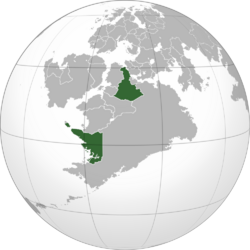Community of Majulan Nations
This article is incomplete because it is pending further input from participants, or it is a work-in-progress by one author. Please comment on this article's talk page to share your input, comments and questions. Note: To contribute to this article, you may need to seek help from the author(s) of this page. |
 Member states | |
| Abbreviation | CMN |
|---|---|
| Motto | The Light of the Mother Continent Shall Guide The World! |
| Predecessor | Equatorial Community |
| Formation | March 19, 1979 |
| Founded at | Rutete International District |
| Type | Continental Union |
| Purpose | Political and economic cooperation among members |
| Headquarters | Rutete International District1 Gondar2 |
| Location | |
Membership | |
Chair | Laurence Jojomba |
Commissioner | Ayele Yihun Andenet |
Head Councilor | Farijika Duvernay |
Main organ | Majulan Council Majulan Commission |
Budget (2017) | $15 billion |
| 1Seat of MACON 2Seat of MACOM | |
The Community of Majulan Nations (CMN) is a continental union which aspires to unite all nations in Majula under a common supranational organization, common market, and mutual defense organization. It currently consists of three member states. the CMN was established following the Rutete Declaration on 19 March 1979, in which the nations of Marensoald and the Mawusi laid out plans to expand their bilateral relationship to that of a trans-continental organization, chiefly alongside Habasha. The Community was thus brought into being the following year, when the Majulan Council (MACON) was first brought to session in Sahabahina. Key decisions made by the CMN are made by the Majulan Council, an annual meeting of all heads of state and government of each signatory nation. The Community's secretariat is the Majulan Commission (MACOM), and is located in the International District of Rutete.
The CMN covers approximately -AREA-, with current population estimates of -POPULATION-. The most spoken languages in the Community are Midrasian, Arabekhi, Watuwakuu, Mehare, and numerous smaller indigenous dialects. A number of WECO heritage sites are located in the CMN, both historic and natural, including the Nchizakimya Rainforest and River System, the largest in the world.